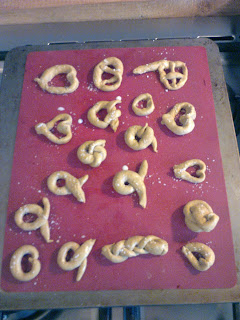
Here's Millie's 5th birthday cake. As ever, it was Nigella's buttermilk birthday cake recipe - the perfect construction cake. I used a massive round cake tin (I think it's 30cm across), and a smaller, 7inch sandwich tin.
You'll need
250g butter
400g white sugar
6 eggs
150g yoghurt mixed with 250ml milk (or 400ml buttermilk)
3 teaspoons vanilla extract
500g plain flour
3 teaspoons baking powder
1 teaspoon bicarb of soda
1/2 teaspoon salt
Stick the oven on at about 180 degrees, and line your cake tin with greaseproof paper (bit fiddly, but worth it).
I did all this in the food processor, as it's a right pain if you have to beat the butter and sugar together by hand (an electric mixer would probably be even easier).
Sling in the butter and sugar, and pulse on a high speed until they are light and fluffy. Slowly add the eggs (one at a time) on a lower speed, until everything's blended together.
Pour the yoghurt, milk and vanilla into a measuring jug, and mix well. In a bowl (or second jug), mix together the flour, baking powder, bicarb and salt. Add a couple of tablespoons of the flour mix to your egg/butter/sugar combo in the food processor, and blitz for 20s or so. Do the same with a couple of tablespoons of the yoghurt/milk/vanilla mix. Repeat ad nauseam until everything is combined. It's a bit of a faff, but does make for a light cake.
Pour into your cake tin, and then bake in the oven for about 35 minutes, until it's golden brown on top and a skewer poked into the middle comes out clean. Cool on a rack for 10 minutes or so in the tin, and then leave to cool, preferably overnight.
Next, assemble your cat. You'll need:
some ready roll white fondant icing (life's too short to make your own)
jam to slather over the cake, so the icing will stick
a little icing sugar, for rolling out the icing
chocolate fingers for whiskers (I tried to find black licorice laces, but couldn't get hold of any in time)
chocolate buttons for eyes
some chocolate icing for piping - I bought some ready-made stuff in a tube, so it was easy to draw on paws and stripes
First, cut your small cake to size, and save two triangles for the ears. Then, melt your jam in a saucepan (or microwave), and brush over the cakes' surfaces. Roll out the fondant icing (if you scatter icing sugar everywhere it shouldn't stick), and carefully cover the cakes and ears.
Add the decoration - stick the chocolate button eyes and chocolate finger whiskers on with the chocolate icing, and draw on some paws and a nose.
Decant into a tin, transport very carefully for 45 minutes in the car, and serve on a windy Northumberland beach.












